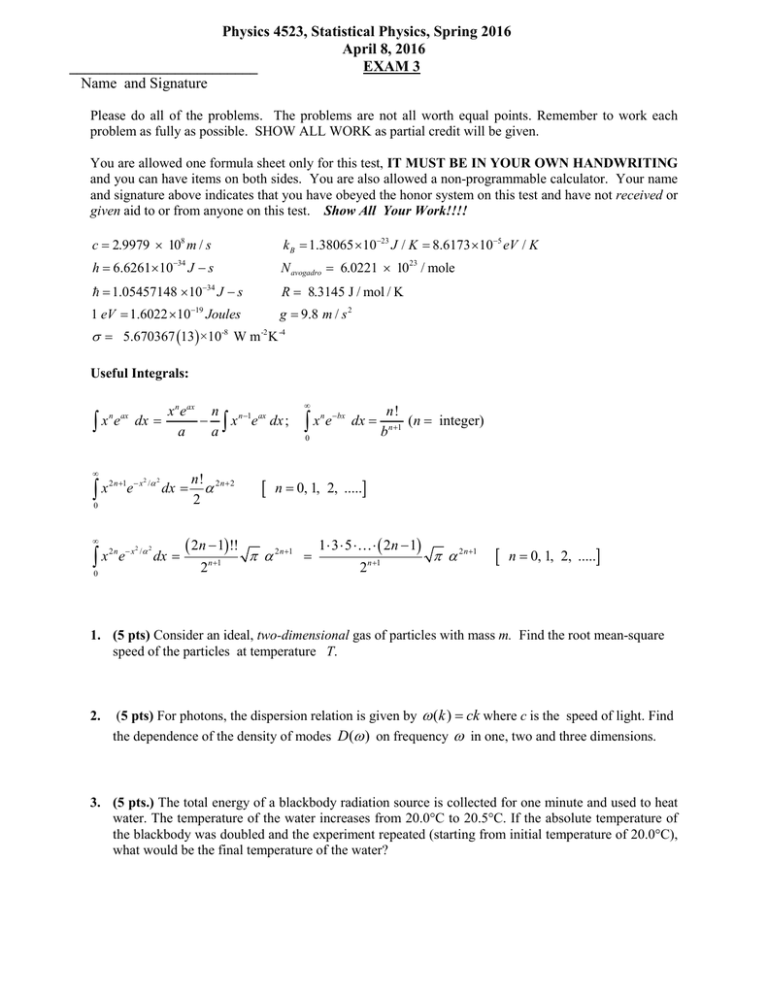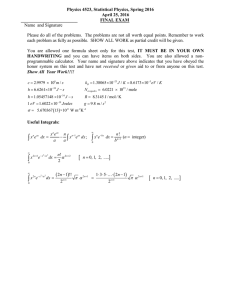Document 10406107
advertisement

Physics 4523, Statistical Physics, Spring 2016 April 8, 2016 _________________________ EXAM 3 Name and Signature Please do all of the problems. The problems are not all worth equal points. Remember to work each problem as fully as possible. SHOW ALL WORK as partial credit will be given. You are allowed one formula sheet only for this test, IT MUST BE IN YOUR OWN HANDWRITING and you can have items on both sides. You are also allowed a non-programmable calculator. Your name and signature above indicates that you have obeyed the honor system on this test and have not received or given aid to or from anyone on this test. Show All Your Work!!!! c= 2.9979 × 108 m / s kB = 1.38065 ×10-23 J / K = 8.6173 ×10-5 eV / K h = 6.6261×10-34 J - s N avogadro = 6.0221 × 1023 / mole 1.05457148 ×10-34 J - s = -19 1 eV = 1.6022 ×10 Joules = R 8.3145 J / mol / K g= 9.8 m / s 2 s = 5.670367 (13) ×10-8 W m -2 K -4 Useful Integrals: ∞ x n e ax n n −− n! n ax x e dx = − ∫ x 1e ax dx ; ∫ x n e bx dx = (n = integer) ∫ a a b n +1 0 ∞ 2 n +1 − x /a = ∫ x e dx 2 2 0 ∞ 2 n − x /a = ∫ x e dx 2 0 2 n! 2n+2 = a [ n 0, 1, 2, .....] 2 2n − 1) !! (= π a 2 n +1 2 n +1 1 ⋅ 3 ⋅ 5 ⋅ ⋅ ( 2n − 1) = π a 2 n +1 [ n 0, 1, 2, .....] n +1 2 1. (5 pts) Consider an ideal, two-dimensional gas of particles with mass m. Find the root mean-square speed of the particles at temperature T. 2. (5 pts) For photons, the dispersion relation is given by ω (k ) = ck where c is the speed of light. Find the dependence of the density of modes D (ω ) on frequency ω in one, two and three dimensions. 3. (5 pts.) The total energy of a blackbody radiation source is collected for one minute and used to heat water. The temperature of the water increases from 20.0°C to 20.5°C. If the absolute temperature of the blackbody was doubled and the experiment repeated (starting from initial temperature of 20.0°C), what would be the final temperature of the water? 4. (10 pts.) “Ripplons” are small oscillations in the surface of a fluid. They have a dispersion relation ω (k ) = α k 3 / 2 , where α = ( γ s / ρ ) , ρ is the fluid density, and γ s is the surface tension (a 1/2 constant). The ripplons are spinless, and they move in a two-dimensional area A, with wave vector k. a. Find the average energy (at temperature T) in a single ripplon mode of frequency ω . You may ignore any zero point energy. b. Find the high temperature limit of that average energy, for k BT ω. Explain why this is reasonable – that is, why it is consistent with what you expect from classical physics. c. Find the total contribution of all the modes to the surface energy (energy per unit surface area) of the fluid, at temperature T. Express your answer in terms of a dimensionless integral. That is, the integral must not be a function of any system parameters (T, α , etc.). Hence, you can obtain the dependence of the total energy on temperature. 5. (10 pts.) Gibbs sum for a two level system. Consider a system that may be (i) unoccupied with energy zero, (ii) occupied by one particle in either of two states, one of energy zero and one of energy ε , or (iii) occupied by two particles, one particle in each state at the same time. (a) Write down the Gibbs sum (Grand Partition Function) for this system. (Note: this can be factored). (b) Calculate the thermal average occupancy N of the system. (c) Calculate the thermal average occupancy N (ε ) of the state at energy ε . Simplify if you can and comment. 6. (5 pts.) The grand potential, Φ G , is proportional to the volume of the system since both Φ G and V are extensive quantities. A system is attached to a reservoir which fixes both the temperature and the chemical potential. Prove that − ΦG ∂Φ − G = P= . V ∂V µ , T Use this result to prove the relation VdP −− SdT Nd µ = 0.





